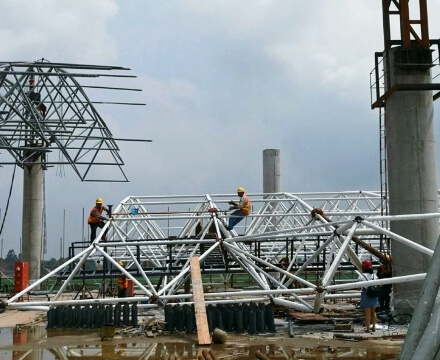Dapeng Town Industrial Park, Tongshan District, Xuzhou City, Jiangsu Province, China

The strength index of steel is determined by elastic σe, yield σy and stretching σu. The design is based on the yield strength of steel. High yield strength can reduce the weight of the structure, save steel and reduce costs. The tensile strength σu is a stress that can be affected before the steel is destroyed. At this time, the steel structure loses its performance due to large plastic deformation, but the steel structure deformation is large and cannot meet the requirements of the structure to resist rare earthquakes. The size of σqi/σy can be regarded as parameters of steel strength reserves.
Steel plasticity usually refers to the characteristics of obvious plastic deformation without rupture after the response point is more than the yield point. The main indicators of measuring steel plastic deformation capacity are the reduction of extension δ and area ψ.
The cold bending performance of the steel is the amount of anti -cracking of the steel when it generates the metamorphosis at room temperature. The cold bending performance of the steel is a cold bending test that tests the curvature deformation performance of the steel with a specified curved degree.
The impact toughness of steel refers to the ability to absorb mechanical kinetic energy when the steel is affected by impact load during the impact. The impact of measured steel’s impact load is a mechanical properties, which may cause brittleness to break due to low-temperature stress concentration. Generally, the impact toughness index of steel is obtained through the impact test of the standard test parts.
Steel welding performance refers to obtaining good welding joints under welding process conditions. Welding performance can be divided into two types: welding performance during welding and welding performance in use performance. The welding performance during the welding process refers to the sensitivity of no thermal cracks or cooling of the metal near the welding and welds to the welding process, so that the cooling and contraction cracks will not produce. Good welding performance means that under certain welding process conditions, welding metals and nearby raw materials will not cause cracks. The welding performance in performance is the impact toughness of the weld and the ductility of the thermal influence area. The mechanical performance of the mechanical properties of steel in the welding and thermal impact area is not lower than the mechanical properties of raw materials. In China, it is a welding performance test method using performance.
There are many factors that affect the durability of steel. First of all, the corrosion resistance of steel must take protection measures to prevent steel from corrosion and rust. Protective measures include: regular maintenance paint, galvanized steel plate, special protection measures under the existence of strong corrosive media (such as acid, alkali, salt, etc.), such as using “anode protection” measures to prevent jackets from corrosion. Zinc ingot is fixed on the sheet, and the seawater electrolyte will first automatically corrode the zinc ingot to protect the steel cover. Secondly, due to the high temperature and long -term load of the steel, its broken strength is much lower than the short -term intensity. Therefore, the long -term intensity of steel at high temperature should be determined. Over time, the steel will automatically become hard and brittle, that is, the phenomenon of “aging”. For steel under low temperature loads, the impact toughness should be tested.